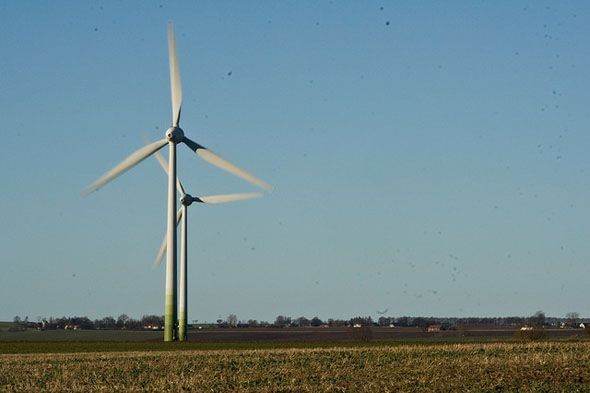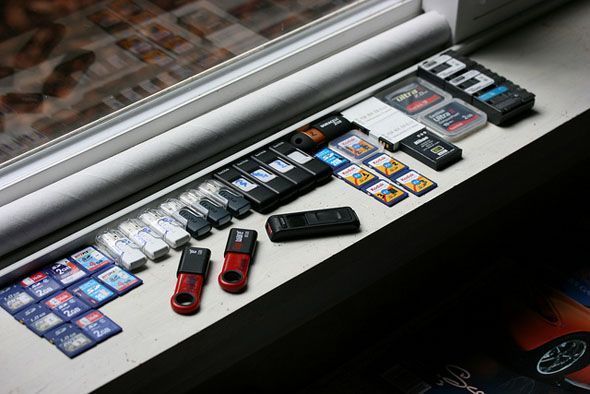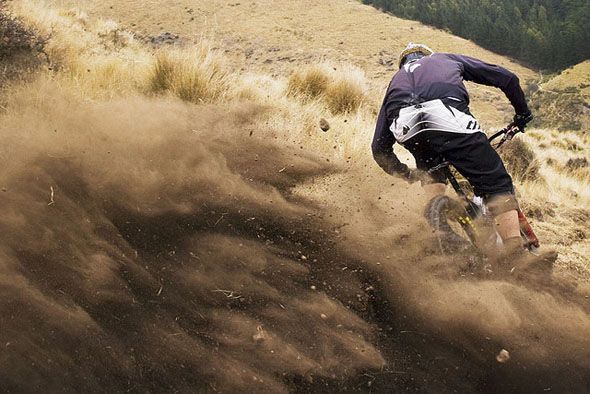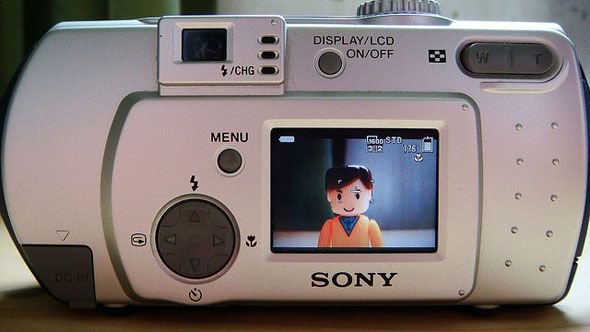What Do I Do With Old Digital Cameras
I have two ageing digital SLR cameras, my offset originally purchased Nikon D50 from 2005 and a Canon EOS-5D which I came across 2nd-hand a few years ago. Despite being an entry-level camera that'due south getting close to its 10th birthday, the D50 is nonetheless very close to my heart being the kickoff digital SLR I owned and learned on, too as being the first camera with which I was able to make some money out of my photography.
The 5D isn't bad either, but it weighs a lot and is showing its age far more than than my Nikon. That said, I've non given up promise on it yet. At that place'southward no reason an former camera like this can't have magnificent photographs, though at that place are a few things to remember when pushing your kit to the limit.
Muddied Cameras Hateful Dirty Photos
No, not those kind of dirty photos - I'm talking well-nigh fungus, dust specks and marks on the glass or sensor. If your former photographic camera is getting on a bit, there's a good chance it could do with a clean. Unless you've only ever changed lenses in a vacuum, you'll have all kinds of fluff and dust to contend with and for that y'all could probably do with a grit blower. They're cheap, $five safe-on-plastic affairs that help dislodge loose debris from your photographic camera's internals.

If the situation is worse than this, don't go touching anything on the within but instead consider getting the camera cleaned for a flat fee. At that place are lots of camera servicing centres that volition thoroughly clean the innards, though you'll want to opt for a wet-make clean using solvents on the sensor if your kit is badly in need of a clean.
It's too possible to buy these sensor cleaning kits online, and doing it yourself is considerably cheaper than paying someone else to do it. That said it's also quite a fiddly operation that requires just enough solvent, the right applicator and a steady mitt. Sensors are delicate, and one fake movement could mean a marked sensor (yes, forever). Which brings u.s. on to the next bespeak…
Sensor Harm
If said fungus or dust has been there for long enough, or you (or someone else) has botched a cleaning job and marked the sensor itself in the by, at that place'southward very footling y'all tin can do. In fact, there's nothing you lot can exercise. That 5D I mentioned earlier? Yeah, information technology's got sensor problems - generally fungus afterward being used as a wild animals photographer's go-to shooter. The only thing yous can do if your sensor is showing up marks or scratches is to cull a wider aperture.

Past shooting with a shallower depth of field, those scratches and marks will be far less obvious (quite possibly invisible) on your images. This ways no high f-stops unless you're excited past the thought of hours spent in post removing marks and imperfections. If you're affected by "sensor blight" it might be best to invest in a 50mm prime number (a nifty l) or other fast lens and shoot broad-open.
Replace Your Batteries
You will undoubtedly need to supercede your old camera's bombardment, particularly if this is something you have never done before. Batteries are notoriously bad at maintaining capacity, but the good news is that you can salve money past ownership third-party batteries. Some 3rd-party batteries even out-perform manufacturer batteries, and seeing as your photographic camera is long past its warranty period you don't have to stick to first-political party replacements whatever more than.

Remember to recycle your quondam batteries in a responsible style, rather than merely throwing them in the bin. Some photographic camera shops will fifty-fifty recycle them for you if you ask nicely enough.
Thanks For The Memory (Cards)
Flash memory doesn't last forever, and though it'south unlikely you've personally ever burned through all the available write cycles on a slab of NAND; y'all might want to pick upwards a few spare cards anyway. Many older cameras utilize FAT as a file system which cannot utilize volumes larger than 2GB, so stick to cards below this size.

This might at first seem limiting, it's not actually a big deal because older cameras practise not guzzle space like the xx-something-megapixel full-frame monsters of this era.
Know Your Enemy
When you're shooting with older technology information technology'south important to remember the limitations involved in doing so. Digital cameras take evolved leaps and bounds in the last decade, which makes the older models look outdated and inferior. This isn't necessarily true, and the gap can be narrowed with a amend awareness of your device's abilities.
Low light functioning on older cameras isn't and then hot. It's one of the chief areas where new cameras will put old ones to shame, and then continue information technology in heed. High ISO values volition generate a lot of racket and grain, then you'll need to lower your shutter speed or open up your discontinuity (use a lower f-finish) to let more light into your photographic camera. Always utilize the lowest possible ISO and consider a monopod or tripod for steadier, brighter longer exposures.

Lower read times and smaller memory buffers means that continuous shooting modes will cap-out earlier than modern cameras. This might mean you'll accept to be more conservative with the shutter and more patient when waiting for long-exposures to develop and when waiting for queue of images to be written to memory.
Shoot RAW
Rather than using lossy JPEGs, shoot RAW. Ever. Even on your newer cameras. Why? Because making alterations to exposure, white balance and just most every other variable is infinitely easier with RAW, uncompressed information. This is particularly pertinent when it comes to older cameras, which will often need more touching-upwardly in mail than usual.

Older cameras might not offering the aforementioned level of accuracy when it comes to colour reproduction, temperature or even adequate exposure. Having a RAW file means you can make upwardly for your camera's misgivings in postal service, which makes shooting RAW the all-time manner of getting the most out of your kit. The fact that you're using onetime equipment means that the smaller sensor will produce smaller images which occupy less space on your available memory, fifty-fifty for RAW files which incorporate alot more data than JPEGs.
Consider All Possible Uses
There's no reason your onetime kit tin't exist used alongside your newer equipment, but consider the potential uses for maximum upshot. Theoretically y'all can use your older kit in more risky situations as information technology has less budgetary value attached to it, and would toll far less to replace. Don't forget about protecting your drinking glass, though.

With the purchase of a remote trigger, you could mountain your old camera somewhere and remotely fire it while walking around with your main rig. In a pinch it could serve as a second camera. Provided it's not too heavy an erstwhile digital SLR might make the perfect starter camera for your children, a younger sibling or friend - though be prepared to exist answering questions and demonstrating usage for a few months later on.
Convert To Infrared
Infrared photography used to be all the rage, and all you needed was a scroll of infrared film and some filters to block non-IR low-cal waves. These days our digital cameras are built to keep infrared lightout and so in society to take stunning IR photos you will need to have your camera converted. This tin be an expensive process, with prices starting at around $300 for the full service.

You could of class also practise this yourself, though y'all stand a adequately loftier risk of messing up your camera if you do information technology incorrect. You'll also demand to find instructions for your model (like this one for some Canon EOS models) and to purchase whatever glass or filters you want to use. It'southward not a cheap process, nor an easy one, only the results can exist spectacular as you can come across in a higher place.
Betoken & Shoot?
Digital SLRs are a lot more useful than old betoken and shoots which generally evidence their age far quicker thanks to cheaper, smaller sensors. That's non to say they're useless, particularly if they shoot video, and tin can be mounted on dashboards, bicycles or even pets for capturing the moment (albeit a slightly pixellated 1).

Some can be used as a webcam with the correct drivers, and then research your model and come across if it'south possible. Old webcams make dandy baby monitors, security cameras and more than. Old point and shoots are ideal for use by young children every bit they're automatic, easy to use and fun. I've heard children like fun.
Exercise you accept an one-time SLR? What exercise you utilise it for? Share your tips in the comments, beneath!
Nearly The Author
Source: https://www.makeuseof.com/tag/got-an-old-digital-camera-it-can-still-do-magical-things/
Posted by: reedontomprods.blogspot.com

0 Response to "What Do I Do With Old Digital Cameras"
Post a Comment